Strong gym branding is the most effective way to stand out from your competition. And create lasting connections with members. Read on to learn how to build a brand that will help your fitness business become well known. Making you the preferred choice for gymgoers.
Want to know a secret? The most successful companies don’t sell products or services. They sell experiences, feelings, and ideas. All aligned to a distinct and deliberate brand.
Think of brands like Apple, Google, and Coca-Cola. These household names have all created a consistent and considered consumer experience. A controlled experience consumers get whenever they interact with the business.
The ability to control the consumer experience at every level is a result of powerful branding.
Good news! Creating a controlled, branded experience is possible for every gym and fitness business.
Big or small, established or just starting out, this guide will help you create a brand that drives business growth. So, you attract more members who become loyal fans of your business.
Let’s get stuck in!
Power up your business & stay in the know
What is a gym brand?
Your gym brand is the identity and story of your fitness business. It should help you stand out from your competitors. The goal of your brand is to win space in the hearts and minds of your target members, so you become their gym of choice.
Your gym brand is more than just your logo, colours, visuals, premises, website, mission, or any other part of your business. Every part of your business makes up your brand. And that includes every touchpoint with prospects and members.
What is gym branding?
Gym branding is the process of building the brand identity of your fitness business. Through the branding process all the materials that support your brand should be created. For example, your logo, tagline, visual guidelines, and tone of voice.
The branding process involves researching, developing, and applying distinctive features to your business. So, your target audience can identify your offerings fast. Your brand identity needs to exist everywhere. Enticing prospects to choose your club over other options.
Why is your branding important?
Tempted to create a logo, choose some brand colours, and call it a day with branding? You’ll be missing out. Your brand is one of your company’s most valuable assets.
Invest in building your brand to become memorable. Create fast connections with your target audience. Attract (and keep) star employees. Support your gym marketing. And more!
Spend time on branding and everything else will come faster.
Top benefits of having comprehensive, strong branding:
- Brand recognition – make it easy for prospective and existing members to recall and identify your business. Strong brand recognition means it’s easy to differentiate your gym from competitors. And harder for prospects to accidentally sign up to the wrong club!
- Consistency & direction – create order and stay consistent across every member touchpoint with less effort. Strong branding will help inform your next business move. It will make marketing your gym easier. And help you stay aligned to your values
- Loyalty – a 2022 survey found that 73% of UK consumers consider themselves loyal to certain brands (up from 55% in 2021). Build a brand that your members buy into. Pair a consistently positive experience with an offer that keeps anticipating their needs
- Recommendations – when members emotionally connect with your brand, they’re much more likely to become brand ambassadors. And spread the word about your business to friends and family. People are 90% more likely to trust and buy from a brand recommended by a friend. And what does that mean? Free marketing for your business!
- Effective advertising – ads that come from a strong brand are more likely to be met with curiosity and trust. Ultimately, your ads will become more effective at achieving your desired goal. For example, you’ll have more prospects sign up to a new membership or see more bookings for a new class you’ve added
- Price sensitivity – with a positive emotional connection and satisfying past experiences with your brand, members become less price sensitive. So, cost becomes less of an issue in their decision to join or stick with you. This can also make it easier to raise prices when you need to
- Employer of choice – your people are your business and an extension of your brand. Your brand can also help you attract and keep superstar gym staff. A strong brand will offer employees something that they can’t find elsewhere. And motivate them to perform at a high level
Achieving growth through your brand
At the recent Xplor Xperience event, Adrian Marks, from marketing agency enjoy! shared details of his brand framework to help gyms achieve growth through branding.
Adrian explained that there are 3 steps to building brands that people buy into:
- Understand why people buy things – only 10% of a decision to buy is driven by logic, the other 90% is down to emotion and instinct. People are motivated by pain and pleasure to solve for basic needs influencing spending decisions. Appeal to their needs through your branding
- Know how people buy things – there are 7 steps that most people move through when buying. They identify a need for something. Grow to like a brand. Consider purchasing. Develop confidence and trust. Place value on a product/service. Buy. And finally, build the habit of using that purchase. Take your target audience on this journey
- Align sales & marketing around why people buy – create a brand that speaks to the needs of your target audience. Then build your brand experience around that
For more on building a brand that drives growth, check out this article.
Building your gym brand
Before you dive into working on elements of your gym branding like your logo, colours, and even your name, start by doing some background work. This will help set you up for branding success.
Outline your values, qualities, and benefits
Think beyond profitability, success and recognition. And consider what the emotional driving force behind your business is.
Do you want to help people live healthier lives? Want to create a space dedicated to bodybuilding? Or help build body positivity?
Think about why you’ve chosen to be in the fitness industry, why you’re passionate about it, and what you’d like to contribute. Write it down! Create a list of what sets your business apart from others. Focus on how you’ll enhance lives rather than features or services.
“When we know WHY we do what we do, everything falls into place.
When we don’t, we have to push things into place.”
Simon Sinek
At this stage, you could write your mission and vision statement. This will be the building blocks of your gym brand. And will quickly and clearly explain why your company exists. As well as why people should care about your brand.
Study your competition
By researching your competition, you can establish your brand positioning. And that means you’ll have a clear idea of what you’re offering in comparison to other gyms and fitness businesses.
What are they doing well? What are they doing that’s not so great? How will you be different? Why will people choose your gym?
Perhaps you want to be a more efficient version of similar gyms. Or you’re positioning your club to address what’s lacking in the market to satisfy a need that others don’t.
Get to know your target audience
Next up, think about who your target audience is and what their needs are. 70% of consumers want brands to provide a personalised experience. And to give a personalised experience, you need a clear idea of who your target audience is.
Who are you serving? Who is your ideal member? Why did you create your business? What needs are you solving for your ideal member?
Think about a few different types of ideal member. Create member personas. A member persona (also referred to as a buyer persona) is a fictional representation of your ideal members. It’s based on data and insights from your target audience.
A member persona gives you a detailed profile of your typical member. Personas will include typical:
- Demographic details
- Work backgrounds
- Goals and challenges
- Needs and feelings
- Decision-making criteria
- Communications preferences
- And buying behaviour
Rough personas are better than perfect personas. So, don’t worry if your personas aren’t this comprehensive. Really this is about knowing your ideal members well enough to find ways to connect with and appeal to them.
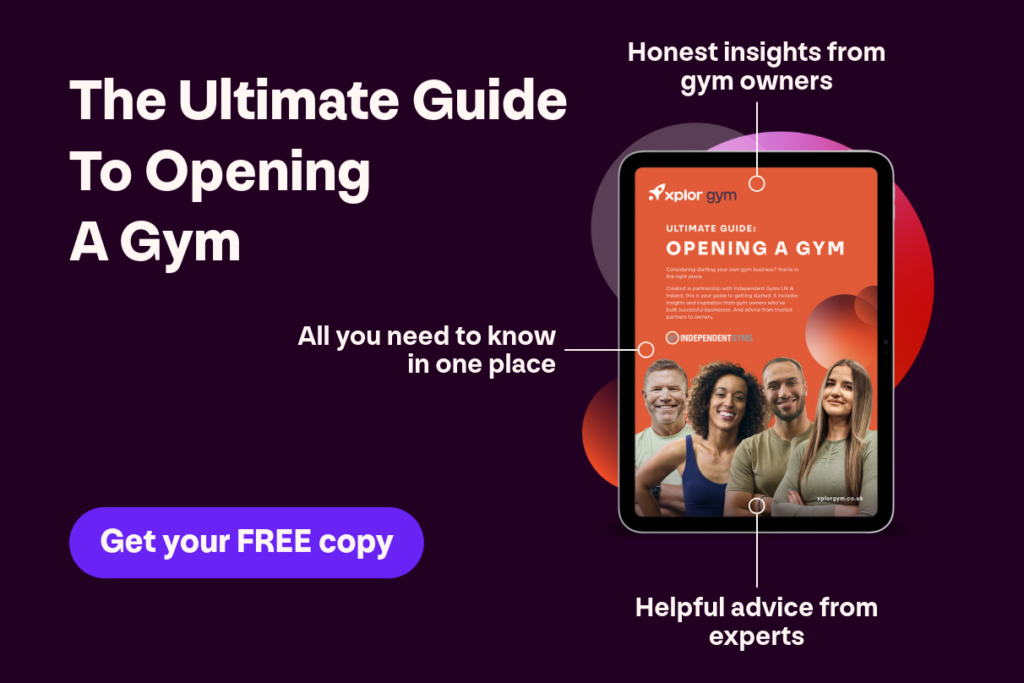
Choosing a gym brand name
Now you’ve defined why your brand exists and what you’re trying to achieve. And you know your competitors and target audience. So, it’s time to think about your brand name.
Finding the right name can be exciting, tiring, and frustrating all at the same time! You may already have a gym name in mind. Or perhaps you’re not sure where to start?
There are plenty of tools available to help you brainstorm – Shopify’s business name generator and Brand Bucket’s name and URL finder for example. Try thinking of names that fit into these categories:
- Founder (e.g., Cadbury, Aston Martin, Guinness)
- Descriptive (e.g., Whole Foods, Booking.com, The Gym Group)
- Fabricated (e.g., Google, Kodak, Xerox)
- Acronym (e.g., BMW, HSBC, UPS)
- Magical spell – two words together or a real world word with a made-up spelling (e.g., Facebook, Trainline, Xplor)
Make sure you choose, screen, and test out your gym brand name well. The best brand names are:
- Meaningful – conveying your value and mission
- Distinctive – standing out in a memorable way
- Accessible – easy to understand, say, spell, and, in today’s world, Google too!
- Protectable – you should be able to trademark it, get the domain you want, and own it
- Future-proof – growing with you and maintaining relevance as your business evolves
- Visual – the best names can be translated visually into logos, icons, etc.
Designing a logo
Once you have a brand name for your gym business, you’ll need a logo. Your logo has the power to impact how your gym is perceived.
Designing a timeless logo is challenging. Consider investing in a designer or marketing agency experienced in creating compelling brands.
There are 7 main categories of logo design:
- Abstract mark
- Mascot
- Combination mark
- Emblem logo
- Lettermark
- Pictorial mark
- Word mark

A logo that expresses your brand visually can help your business grow faster.
Create a gym logo in 8 steps
Generally these are the steps to follow when designing a logo:
- Know your brand – your values, mission, what makes you different, your audience, your name etc.
- Create some initial sketches – guided by your brand story keeping it simple, unique, and strategically using colour
- Choose a sketch and fine-tune it – pick the sketch that stands out most and think about your brand to work out how it can better reflect your brand
- Develop your logo’s layout on a design platform – Adobe Express, Looka & Canva all have free logo creation tools
- Choose your colours – your colour palette says a lot about your brand. Consider the psychology of different colours
- Pick a font – combine text with imagery. This is especially important if you’ve chosen a wordmark or lettermark logo. A serif font (with stems on each letter) is classic, a sans serif font (no stems) is modern
- Make sure your logo is scalable – your logo needs to be legible regardless of size. So, you can use it anywhere (e.g., your website, social media, posters, signage, etc.)
- Gather constructive feedback – see what others think of your logo
Consider creating a submark logo to use on social media. A submark is a simple, small, identifiable brand design. And create a favicon too. This is a small icon used for your website that appears in the browser tab and in search results.

Other gym branding elements to create
If you want to create a gym brand that makes a lasting impression, your approach to branding will need to extend beyond your name and logo. Here’s what else to consider during the gym branding process:
Tone of voice & words
What would your gym brand sound like if you had a conversation with it? Define a brand voice that will connect and resonate with your target audience. Get their attention and keep it.
By defining your tone of voice, you’ll be able to make sure that it’s consistent. Prospects and members will come to recognise your voice. Create a fun, entertaining voice, and your members will look forward to hearing from you. Be human!
Colour palette
Different colours can conjure up different emotions in your target audience. As well as adding personality to your brand.
Choose the colours that make sense for your gym brand’s identity. Your colours will be present across your facilities and marketing materials. So, use them to motivate members.
Start by looking at the colours in your logo and consider colour psychology. These are the emotions typically evoked by colours:
- Yellow – optimism, clarity, warmth
- Orange – friendly, cheerful, confidence
- Red – excitement, bold, youthful
- Purple – creative, imaginative, wise
- Blue – trust, strength, dependable
- Green – peaceful, health, growth
- Grey – balance, calm, neutral
Also keep in mind colour theory and the need to choose colours that complement each other.
Typography/fonts
You may have looked at fonts when designing your logo. The typography you choose can say a lot about your brand. Directness. Confidence. Calm.
From a modern sans serif font to a traditional serif font, consider what will work best for your brand and target audience. Make sure your choice works with your colour palette. And check for accessibility too.
Imagery
As the cliché goes ‘a picture is worth a thousand words’. And that’s very true for gym branding. The images you choose will show who you are and who should be a part of your club.
Align your image choice to the value your gym brand will bring to people’s lives. Be relatable. Inspire your target audience. Show what you have to offer. Consider how stylistic vs. realistic imagery should be.
Your imagery will introduce people to your brand and show them what to expect. So, make sure you’re catching the attention of the right people.
Space
Align the look and feel of your facilities to your gym branding. Think about:
- Layout
- Lighting
- Equipment
- Windows
- Wall art & decoration
- Flooring
The experience of visiting your space should meet the expectations set by your marketing.
Scent
If you really want to go the extra mile, consider the scent of your gym or fitness club. By choosing a specific fragrance for your gym you can evoke a feeling in members.
A positive memory of a pleasant smell – like finishing a satisfying workout – will create emotions that keep members coming back. Consider having this scent in areas like your changing rooms, entrance, and workout areas.
Create & maintain brand guidelines
Once you’ve invested in creating your brand, get it all down on paper (so to speak) by creating brand guidelines.
Brand guidelines are the set of rules that define your brand look and feel. Plus, they cover how your brand sounds too.
Taking time to document your gym branding and making sure guidelines are followed will create consistency. And much like working out, consistency is key to success when creating a recognisable brand.
Typically brand guidelines will include:
- Mission statement
- Core values
- Brand tone of voice
- Logo & typography usage
- Colour palette
- Imagery – photos, illustrations, icons
Roll out your gym branding
Your branding should run throughout your business. Start by letting your gym staff and other stakeholders know about your branding. Get their buy in. And give everyone easy access to your brand guidelines.
Website
Your website is a significant part of your identity, so make sure it reflects your brand. Use the correct colour palette, imagery, and typography. Make sure all copy (wording) reflects your brand voice. Remember that includes your call-to-actions as well.
Social media
Whether you are on Instagram, Facebook, TikTok or any other social platform, your profile photos, cover images, and posts need to reflect your brand.
Typically your logo, or a submark logo (smaller and simpler version of your logo), should be your profile photo. This makes it easy for people to recognise the account belongs to your gym.
Also make sure social handles (e.g. @xplorgym_uk) and URLs (e.g. https://www.linkedin.com/showcase/xplor-gym-uk) are on brand.
Advertising
Your gym advertising is often the first time your target audience sees your business. Ads raise brand awareness. So, they need to be on brand.
Your brand guidelines will make creating ads easier and faster. How? Image choices, copy, and other visual elements will be determined using your guidelines. Less time spent deliberating and making fresh choices.
Sales, front of house & other support
Every member of your team is an extension of your brand. That’s especially true for those who engage directly with your members. Encourage and empower them to use your brand voice, logo and imagery.
And any communications templates you use (for example, emails) should reflect your gym branding.
Member experience
Apply your branding to your facilities (think about scent too). And remember to have your gym membership software and app branded. So, your members get a consistent experience when they manage their membership, book classes, access workouts, and more!
33 evergreen gym marketing ideas
TipA strong brand will make marketing easier. Get timeless marketing ideas to boost your brand and business.
Gym marketing ideasTime for a rebrand?
Once your business is established, you may decide it’s time to rebrand. There are several times when a rebrand is appropriate:
- You’ve never invested in building a brand – perhaps you just wanted to dive straight into business, but as you grow branding is becoming a bigger consideration
- Your vision has changed – if your goals have significantly changed then you may need to reevaluate your positioning. For example if you were a PT studio and now offer gym access
- Your target audience has changed – if you’re targeting a new audience (or your original target group has aged) you may need to reposition your brand
- Landscape has changed – as new technologies and competition emerge, and tastes change, you may want to rebrand to stay relevant
- Legal or PR reason for the change – sometimes you may find yourself treading on someone else’s toes. Or unwittingly associated with something or someone that’s not good for business. Both call for a change
Rebrand approaches
If you’ve found your business in a position where you need to rebrand, there are a couple of options:
- Refresh – if your brand is already recognised and respected, you may be able to tweak and update it to move with the times
- Complete makeover – if you need to completely change your identity (or make some major changes), you may want to make a full rebrand to move away from your existing brand
The process of rebranding will be like the branding process. Although, you’re likely to be able to run much more detailed target audience research. And really build an understanding of how your current brand is seen.
Examples of powerful gym brands
Want some gym branding inspiration? Here are some examples of powerful brands in the gym space to inspire you:
1. Gymbox
Gymbox is the antidote to boring gyms, injecting a sense of fun and excitement into visiting the gym. The distinct branding perfectly portrays this.
The brand has a distinctive visual identity and tone of voice. Simple graphics and a black on yellow colour palette help Gymbox standout. And provocative, distinctive copy let you know that Gymbox is not your average gym.
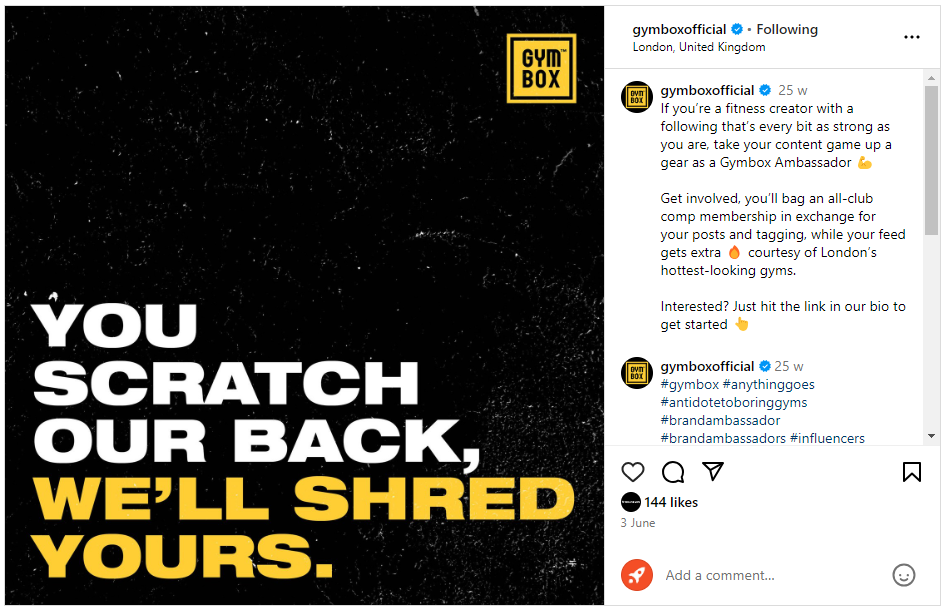
2. The Gym Group
The Gym Group rebranded in 2022, evolving an already recognisable brand to celebrate the company purpose. The brand’s purpose has always been the same – to breakdown barriers to fitness for all.
The refreshed branding champions every gymgoer with the message ‘we’re with you’. Simple but effective, The Gym Group’s branding is highly recognisable.
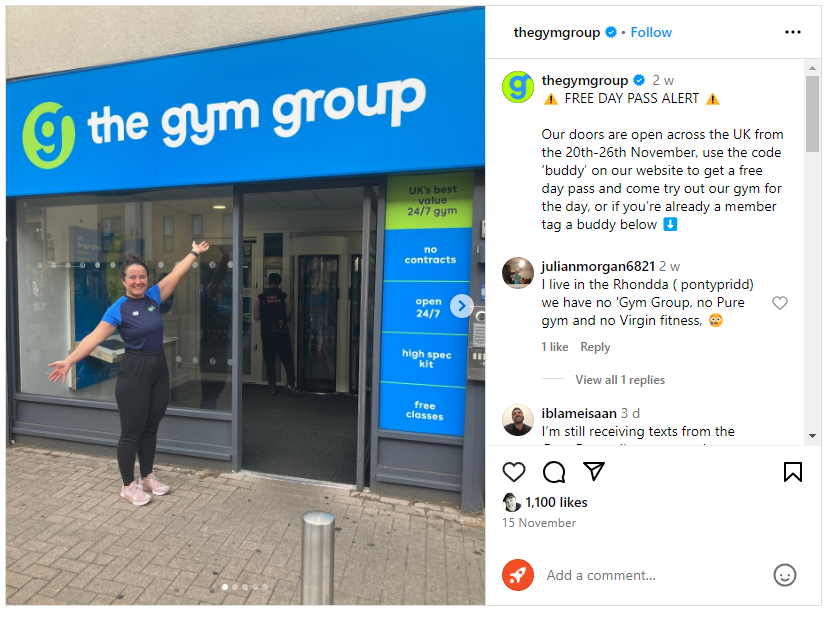
3. Third Space
London-based luxury club operator, Third Space, looks to engage and excite gymgoers, motivating and making it easier for them to actually visit.
Third Space branding is designed to inspire. And a Third Space location has a very distinct feel – mixing luxury with primal.
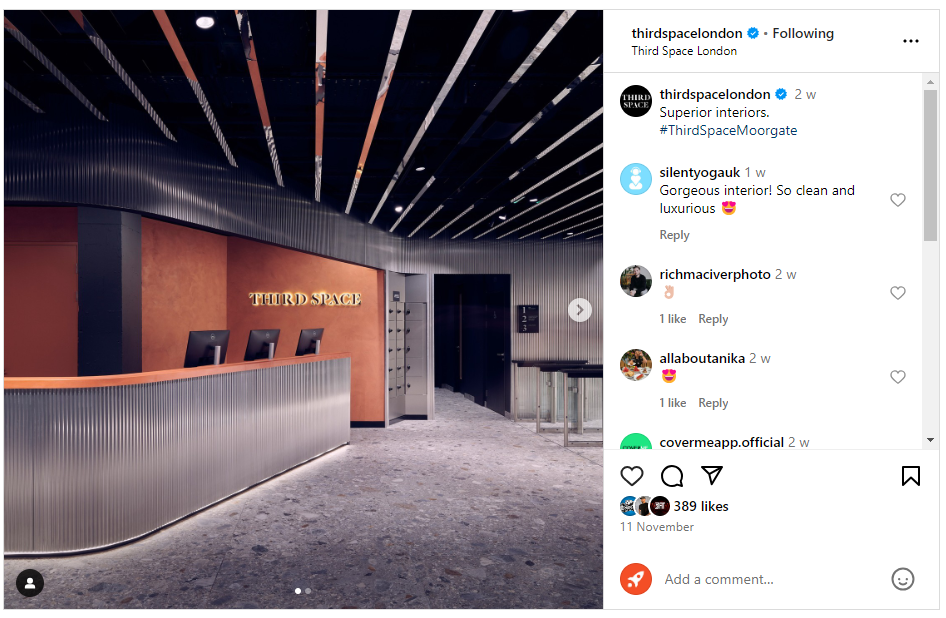
4. Graft Häus
Leeds-based gym, Graft Häus was created to be the best gym in an area packed with fitness options. A gym of choice for gymgoers and top level PTs alike, Graft Häus has a unique brand identity.
With a modern feel, the brand pairs simplicity with a sense of fun. A clean black and white colour palette translates perfectly across the digital and in-person member (or should we say Gräfter!) experience.
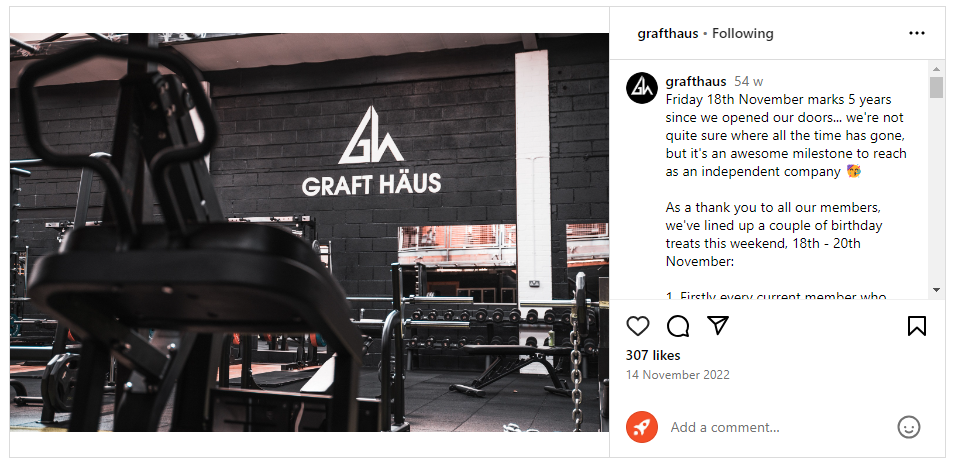
The wrap up…
Gym branding can elevate and speed up the success of your fitness business.
Created with your values, market positioning, and target audience in mind, your brand will help you create consistent, considered member experiences. And place you amongst the most successful companies, selling experiences rather than products and services.
Your brand is more than just a logo. It should run through every part of your business. Every element of your business and every interaction should align to your brand.
Investing in powerful, comprehensive branding will build recognition. And help you connect with your target members. Plus, with the right branding you’ll see increased loyalty, generate more recommendations, and attract members willing to pay more.
Branding isn’t all about members. It can help you attract and retain talented staff members. When your team has a clear understanding of what your business is all about and what you stand for, they become more connected and invested.
Above all, effective gym branding can be a significant driver for growth. Appealing to the needs and emotions of your target audience, your staff, and others to inspire buy-in.
Choose gym management software that can help you create member experiences that align to your brand. Book a demo to see Xplor Gym in action.

by Joanna Ashton Content Marketing Manager, Xplor Gym
-
First published: 04 December 2023
Written by: Joanna Ashton
